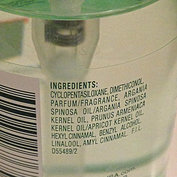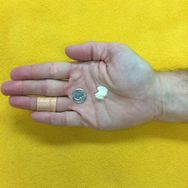
When was the last time you tried reading the label on your
favorite lotion, soap, shampoo, or cosmetic? The dizzying number of complex
ingredient names on many products can leave even the most discerning consumer
confused.
Indeed, many of us assume that the ingredients in our personal
care products have been government tested and deemed safe. In truth,
however, there may be less government regulation and oversight of
cosmetics and similar products than you may think.
While
the U.S. Food and Drug Administration prohibits
the misrepresentation or misbranding of products, it does not require
ingredients, other than color additives, to have the agency’s approval before
going on the market. It is the responsibility of those
who make or market personal care products to ensure that they are safe.
Chemicals in our personal products can be unhealthy not only
for us but for wildlife and aquatic environments, too. Wastewater treatment
facilities are not designed to effectively remove these chemicals, so
they can end up in our lakes, streams and other water bodies, where they accumulate in fish and other creatures. They can also turn up in our drinking
water.
|
What to do?
Here are some general guidelines to help you choose and use products.
-
Buy
products that are simple, meaning they contain the fewest ingredients possible.
A long ingredient list doesn’t necessarily mean you’re getting more great
ingredients. It can mean that the product contains a lot of fillers like preservatives, surfactants,
and emulsifiers.
 -
Avoid
siloxanes. Any ingredient ending in "siloxane" or “cone” (such as dimethicone) is a siloxane.
They are toxic to aquatic life and cause a lot of trouble at wastewater
treatment plants.
-
Avoid
synthetic fragrance. Look for the term “fragrance free.” Products labeled
“unscented” can contain fragrance that masks the product’s natural odor.
-
Avoid
synthetic dyes. They have no function in your product. This is simply a
brand’s attempt to set itself apart from other brands, or to make products more appealing. Dyes are easy to spot on labels. Anything
with a color name (D&C Red) is a synthetic dye.
|
 -
Make your
own when you can. It’s easier than you think! Not only will you avoid toxic
ingredients, you will save money. A few recipes are provided below to get you
started.
-
Use the
smallest amount of product needed to do the job. Typically, this is considerably
less than what the product instructions state.
-
Use the
fewest number of products to do the job. You don’t need different shampoos or other products
for you, your children, and your spouse. Find one that you feel good about and
use it for the whole family.
-
Choose products that can serve multiple purposes. A product like witch hazel, for instance, can replace skin cleanser and astringent.
-
Buy things in containers that can be
reused, and then reuse them! Avoid plastic containers, which
can leach chemicals into your product.
-
Look for
ingredients that you could eat.
-
Be leary of products that are labeled, for example, “natural,”
“botanical,” or “pure.” These designations can be misleading and products with these labels may still contain toxic
ingredients.
|

Make your own
Creating your own personal care products can be both economical and better for the environment. By reusing the same glass jars to contain your products, you can reduce waste that would otherwise be generated and discarded. Ingredients bought in bulk for creating your products also often come in containers that can be reused numerous times.
You'll also have peace of mind knowing that your products contain no toxic or synthetic chemicals that can expose you or your loved ones to risk or be released into the environment.
Summer Streets, a former esthetician, now environmental
chemist at the MPCA, shared some of her favorite recipes for nontoxic hair and
body care. Consider making these for your own use or to give as gifts!
Whipped body butter recipe
4 oz.
unrefined shea butter (available at most co-ops. An 11 oz. jar costs around
$10)
2 T base
oil. Use any oil you like – sweet almond, jojoba, olive, grapeseed, etc.
10 – 20
drops essential oil (optional)
Put shea butter and
base oil in a bowl. Whip with beaters until combined and fluffy. You can then
gently incorporate essential oils and transfer the whole thing to a glass
jar. You can split this into portions: a large portion for body, a smaller
portion for hands, and an even smaller portion for eye cream. Consider adding essential
oils geared toward a specific use/desired outcome (such as anti-aging or
anti-eye bags) and add to each portion. NOTE: if you split portions you will
need to adjust the amount of essential oil you add. The amount suggested is for
the full batch. This is especially good in winter.
A good summertime body moisturizer, says Summer, is straight sweet almond oil (can also be used as eye
makeup remover and facial cleansing oil).
Hair and body elixir (conditioner/moisturizer)
Equal parts: Jojoba oil and fractionated
coconut oil (stays liquid at room temperature)
Essential oils, optional. The
amount depends on how much elixir you make. General rule of thumb is that the
essential oil should account for only 1 – 2 % of the final blend, that is, 6
drops EO per 1 oz. of carrier oil = 1% dilution.
Example recipe:
4 oz. jojoba oil
4 oz. fractionated coconut oil
Up to 48 total drops of essential
oil
This is great as a body
moisturizer. Also provides nice moisture and sheen to hair. A little bit goes a
very long way!
Both of these products have long
shelf lives and do not require refrigeration or addition of a preservative.
Just be careful to use bowls, jars, and utensils that are completely dry! Water
= mold = spoilage.
For more recipes or for guidance or training on DIY personal care products, check with your local community education program or local CO-OP. The internet is another great source for recipes.
More information
Madesafe. National
certification program for nontoxic products. Has a searchable online product
database, as well as information on chemicals to avoid. www.madesafe.org
Environmental Working Group’s Skin Deep Cosmetics
Database. Provides profiles on
thousands of cosmetics and personal products. http://www.ewg.org/skindeep/
What's in our water? Research by the MPCA
confirms that a wide variety of unregulated chemicals are ending up in
Minnesota's lakes and rivers. The chemicals, including pharmaceuticals
and personal care products, are of concern because many have properties
that can interfere with the functioning of hormones in animals and
people.
|
Need a new furnace or boiler for the upcoming winter? The Minnesota Department of Commerce provides some suggestions for how to pay for it at https://goo.gl/HFhtnX .
Smithsonian Water/Ways Exhibit. Goodhue County Historical Society, Red Wing, MN, October 1 - November 13. Don't pass up this chance to see the Smithsonian in Minnesota! This exhibit is kid and family friendly. Water/Ways is part of the Smithsonian's Museum on Main Street
program. Each local host community will use the national water story in
the Smithsonian exhibition as a jumping off point to tell their local
water stories: the history; sacredness to Minnesota’s first people, the
Dakota and Ojibwe; current stresses on water; and how water affects
every element of life. Information: http://www.exploreminnesota.com/events/27450/smithsonian-waterways-exhibit-
Climate Adaptation: Transforming Awareness into Action. Wednesday, October 5, 6:30pm to 8:30pm. Continuing Education & Conference Center, St. Paul, MN.
In this seminar, award-winning climatologist Mark Seeley will survey the
evidence and consequences of climate change in Minnesota. But more, he
will detail the climate adaptation needs and practices that are being
researched by a group of people from private industries; local, state,
and federal agencies; and universities, including the University of
Minnesota. Register at: https://goo.gl/tjR1P9
Landscape for the River Workshop: Native Plants, Raingardens, Lawn Care for Water Quality (+ Winter Tips). Tuesday, October 18, 6:00pm to 8:00pm. Angry Inch Brewery, Lakeville, MN. Whether you're interested in a smaller native planting or want to
transform your whole yard into a force for clean water, this FMR
workshop can help jumpstart your spring planning. We'll also touch on
practices to make your yard (and sidewalks) river-friendlier this
winter. Information and registration: https://goo.gl/ndCyHi
Thank you for reading Living
Green 365. This newsletter is a publication of the Minnesota Pollution Control
Agency. Please send questions or comments about living green to the address
below.
Sincerely,
Erin Barnes-Driscoll and the Living Green Team
livinggreen365.pca@state.mn.us
|